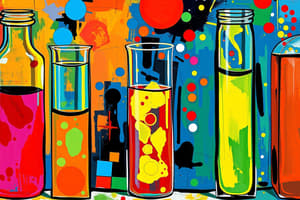Podcast
Questions and Answers
What is a critical requirement for the chemical reaction used in an indirect assay?
What is a critical requirement for the chemical reaction used in an indirect assay?
- It should produce multiple measurable products.
- It must be specific for the compound of interest. (correct)
- It should involve multiple compounds reacting simultaneously.
- It needs to be rapid, resulting in immediate results.
What is the purpose of measuring absorbance relative to a reagent blank?
What is the purpose of measuring absorbance relative to a reagent blank?
- To determine the concentration of all compounds in a sample.
- To compare the absorbance of different samples without any standard.
- To eliminate the need for standard curves in an assay.
- To correct for absorbance contributions from the reagents. (correct)
Which statement best describes the nature of standard curves in biochemical assays?
Which statement best describes the nature of standard curves in biochemical assays?
- They cannot be used if the absorbance is set to zero.
- They should always be nonlinear for accurate results.
- They rely solely on qualitative data from reactions.
- They are typically linear according to Beer’s Lambert Law. (correct)
What is an important characteristic of assay sensitivity?
What is an important characteristic of assay sensitivity?
In biochemical assays, what is the main advantage of indirect assay procedures over direct weighing?
In biochemical assays, what is the main advantage of indirect assay procedures over direct weighing?
What is essential for the absorbance readings in a biochemical assay to be taken accurately?
What is essential for the absorbance readings in a biochemical assay to be taken accurately?
When establishing a standard curve for a biochemical assay, what is the recommended number of points to include?
When establishing a standard curve for a biochemical assay, what is the recommended number of points to include?
Why is the choice of the volume of unknown solution critical in a biochemical assay?
Why is the choice of the volume of unknown solution critical in a biochemical assay?
What must be ensured for the colour change produced in a biochemical assay?
What must be ensured for the colour change produced in a biochemical assay?
What is a recommended practice when carrying out the assay procedure?
What is a recommended practice when carrying out the assay procedure?
Flashcards are hidden until you start studying
Study Notes
Biochemical Assays
- Purpose: Determine the concentration of a specific substance within a sample.
- Direct Assays: Involve weighing the amount of a compound (gravimetric determination).
- Indirect Assays: Used for complex biological samples where direct weighing is impossible.
- Indirect Assay Procedure:
- Select a specific chemical reaction that only the compound of interest will participate in.
- React known amounts of the compound with reagents to produce a measurable product (standards).
- Measure the response of a known volume of sample using the same procedure as the standards.
- Compare the sample's absorbance to the standards to calculate the compound's concentration.
Absorbance Measurement
- Relative to Water: Provides an absolute absorbance value.
- Relative to Reagent Blank: Provides a relative absorbance value.
- Reagent Blank: Contains no compound being assayed; solvent replaces the sample.
- Reagent Blank Purpose: Corrects for absorbance contributions from reagents used in color development.
Standard Curves
- Typical Shape: Linear due to Beer-Lambert Law (A = kcl).
- Desired Assay Properties:
- High Sensitivity: Detects small amounts of the compound, minimizing sample use.
- Specificity: Reaction is specific for the compound of interest, unaffected by other substances.
- Stability: Color development is stable for accurate absorbance readings.
- Proportionality: Color change is proportional to the compound's amount.
Assay Steps
- Choose the Assay: Select an appropriate method based on the compound of interest.
- Choose Standards:
- Determine the appropriate range for the chosen assay.
- Decide the number of standards points (5-6) and their values.
- Generate a standard curve using known concentrations of the compound.
- Set Up Standards: Prepare a standard solution and calculate the volumes needed for each concentration.
- Choose the Appropriate Volume of Unknown: Select a volume that will yield absorbance within the linear portion of the standard curve.
- A volume too small will result in low absorbance.
- A volume too large will result in absorbance exceeding the standard curve's range.
- Carry Out the Assay Procedure: Run the assay on both the unknowns and standards simultaneously.
Studying That Suits You
Use AI to generate personalized quizzes and flashcards to suit your learning preferences.





